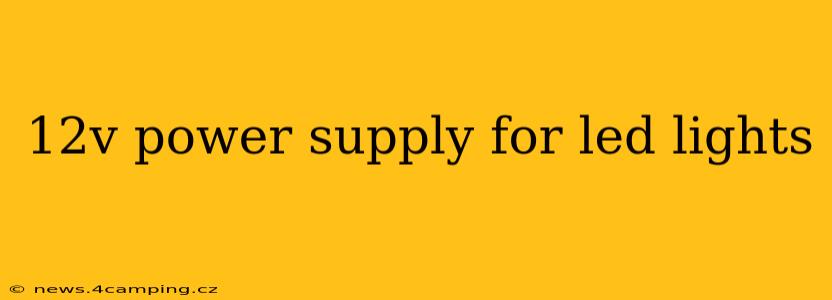Choosing the right 12V power supply for your LED lights is crucial for ensuring their longevity and optimal performance. A poorly chosen power supply can lead to flickering lights, reduced brightness, or even damage to your LEDs. This guide will walk you through everything you need to know to select the perfect 12V power supply for your needs.
What is a 12V Power Supply?
A 12V power supply is a device that converts higher-voltage AC power (typically from your wall outlet) into lower-voltage DC power (12 volts), which is what most LED lights require. These supplies are often called transformers, adapters, or simply power bricks. They are essential components for safely and efficiently powering your LED lights.
How to Choose the Right 12V Power Supply for Your LED Lights
Selecting the appropriate 12V power supply hinges on several key factors:
1. Voltage:
This is the most crucial specification. Your LED lights will clearly state their required voltage – make sure it's 12V DC. Using a power supply with an incorrect voltage can severely damage your LEDs.
2. Amperage (Current):
This is equally important. Amperage (measured in amps or A) indicates the amount of current the power supply can deliver. You need a power supply with sufficient amperage to handle the total current draw of all your connected LED lights. Underpowering (using a supply with too few amps) will lead to dim lights, overheating, and potential failure. Overpowering (using a supply with significantly more amps) is generally safe, but unnecessary and wasteful.
How to Calculate Required Amperage:
- Find the amperage rating of each LED light: This should be printed on the light itself or its packaging.
- Add up the amperage ratings of all your lights: This gives you the total amperage requirement.
- Choose a power supply with an amperage rating equal to or slightly higher than the total. A slightly higher amperage provides a safety margin and better longevity for your power supply.
Example: If you have three LED lights, each requiring 0.5A, you need a power supply with at least 1.5A (0.5A x 3 = 1.5A). A 2A power supply would be a good choice.
3. Wattage:
Wattage (measured in watts or W) represents the power consumption of the power supply. It's calculated by multiplying voltage and amperage (Watts = Volts x Amps). While not directly critical for choosing the correct power supply, it helps to understand the power consumption of your lighting setup.
4. Connectors:
Ensure the power supply's output connector matches your LED lights' input connector. Common connectors include barrel connectors (various sizes) and terminal blocks.
5. Certifications and Safety Features:
Look for safety certifications such as UL, CE, or RoHS, which indicate the power supply meets safety standards.
H2: What are the Different Types of 12V Power Supplies?
Several types of 12V power supplies exist, each with its own advantages and disadvantages:
- Wall-Wart Power Supplies: These are compact and commonly used for low-power applications.
- Desktop Power Supplies: These are larger and generally offer higher amperage output, suitable for more demanding LED lighting systems.
- Switching Power Supplies: These are highly efficient and produce less heat compared to linear power supplies.
H2: How Many Amps Do I Need for My 12V LED Lights?
The amperage requirement depends solely on the total power draw of your LED lights. There's no single answer; you must calculate it based on the individual amperage ratings of each light. Remember to add a safety margin when choosing a power supply.
H2: Can I Use a Higher Amperage 12V Power Supply?
Yes, using a power supply with a slightly higher amperage than needed is generally safe and preferable. It provides a buffer and reduces the strain on the power supply, extending its lifespan. However, avoid excessively high amperage ratings, as this is wasteful and offers no additional benefits.
H2: What Happens If I Use the Wrong Power Supply for My LED Lights?
Using an incorrect power supply can lead to several issues, including:
- Dim or flickering lights: Insufficient amperage.
- Overheating and damage to lights: Incorrect voltage or insufficient amperage.
- Reduced lifespan of the LED lights and/or power supply: Consistent strain from underpowering.
- Fire hazard: In extreme cases, if the power supply is damaged and poorly made.
By carefully considering these factors, you can choose the right 12V power supply to ensure your LED lights operate safely, efficiently, and effectively. Remember, consulting the specifications of your LED lights is paramount for accurate selection.
